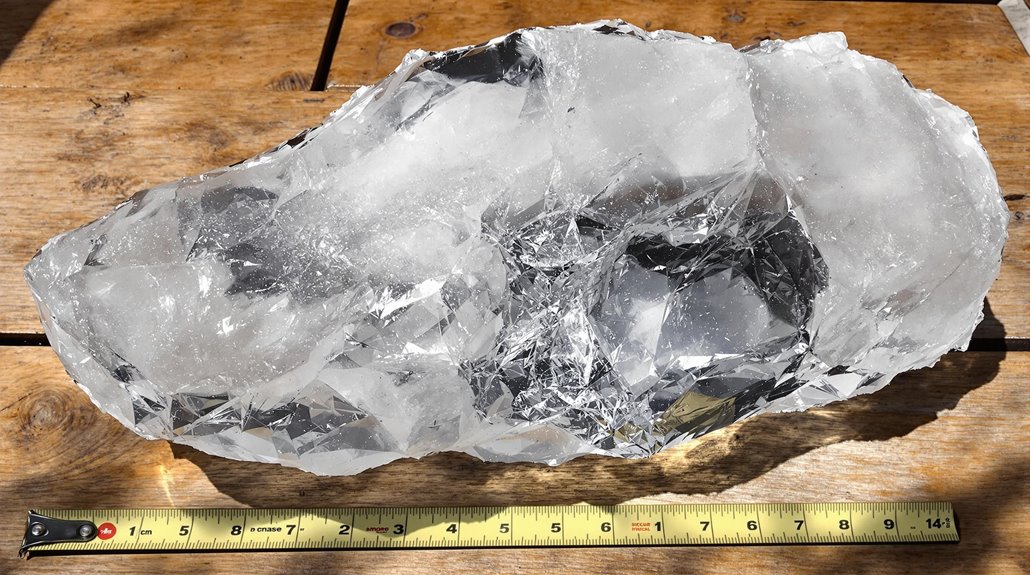The world's largest verified hailstone was discovered in Vivian, South Dakota, on July 23, 2010. This record-breaking specimen measured 20 centimeters (8 inches) in diameter, with a circumference of 47.3 centimeters, and weighed 0.88 kilograms. The National Weather Service and World Meteorological Organization officially confirmed these measurements. While an unconfirmed hailstone from Argentina reportedly measured 23.6 centimeters, the Vivian specimen remains the official record holder. Further analysis reveals fascinating details about this meteorological phenomenon.
Key Takeaways
- The Vivian hailstone from South Dakota holds the official world record for largest diameter at 8 inches (20.3 cm).
- Discovered on July 23, 2010, the Vivian hailstone measured 47.3 cm in circumference and weighed 0.88 kg.
- Bangladesh recorded the heaviest verified hailstone at 2.25 pounds (1.0 kg) in 1986.
- An unconfirmed hailstone from Argentina may exceed the Vivian record with 9.3 inches (23.6 cm) in diameter.
- Aurora, Nebraska, holds the record for largest circumference at 18.75 inches (47.6 cm).
The Record-Breaking Vivian Hailstone
The record-breaking Vivian hailstone, discovered on July 23, 2010, in Vivian, South Dakota, established new benchmarks for hail size in the United States. This extraordinary specimen measured 20 centimeters in diameter with a circumference of 47.3 centimeters and weighed 0.88 kilograms, surpassing previous records from Aurora, Nebraska, and Coffeyville, Kansas.
The Vivian hailstone's significance extends beyond its impressive dimensions. The National Weather Service implemented rigorous hailstone measurement techniques to verify its authenticity.
A formal World Meteorological Organization investigation committee, comprising international meteorological experts, certified the measurements. The verification process, conducted by NOAA's National Climatic Data Center and WMO CCl, confirmed its record-holding status.
The hailstone fell during a severe supercell thunderstorm characterized by high instability and strong wind shear, creating impact pits up to 25 centimeters across the ground and causing substantial structural damage.
How Giant Hailstones Form

Inside thunderstorm clouds, giant hailstones develop through a complex process involving supercooled water droplets and strong updrafts. The hail formation begins when water vapor condenses into droplets that become supercooled in temperatures below freezing. These supercooled droplets freeze onto a condensation nucleus within the hail growth zone, where temperatures range from -10°C to -25°C.
| Growth Phase | Condition | Result |
|---|---|---|
| Initial | Condensation | Water droplet forms |
| Nucleation | Below freezing | Supercooling occurs |
| Wet Growth | Many droplets | Clear ice layer |
| Dry Growth | Few droplets | Opaque ice layer |
| Final | Mass limit | Hailstone falls |
Giant hailstones form through multiple cycles in powerful updrafts reaching speeds of 180 km/h. Each cycle adds new layers through wet or dry growth processes, creating an onion-like structure. The process continues until the hailstone's mass exceeds the updraft's lifting capacity, causing it to fall.
Notable Global Hailstone Records

Since detailed meteorological records began in the early 20th century, global hailstone measurements have established remarkable benchmarks across three primary dimensions: diameter, weight, and circumference.
The most significant diameter measurement was recorded in Vivian, South Dakota, reaching 8 inches (20.3 cm), though an unconfirmed specimen from Villa Carlos Paz, Argentina, potentially exceeded this at 9.3 inches (23.6 cm).
Regarding weight, Bangladesh holds the global record with a 2.25-pound (1.0 kg) hailstone documented in Gopalganj district in 1986.
Circumference records are dominated by U.S. occurrences, with Aurora, Nebraska, recording the largest at 18.75 inches (47.6 cm).
Historical hailstorm events have demonstrated both destructive potential and geographical diversity in global hailstone comparisons.
The 1986 Bangladesh event proved most lethal with 92 fatalities, while North American storms have generated the highest economic impacts, with damages exceeding $2.5 billion in Minneapolis during 2017.
The Science Behind Measuring Hailstones

Modern meteorological research employs diverse scientific techniques to measure and analyze hailstones, ranging from basic geometric measurements to advanced computational methods.
Physical characterization involves thin sections and calorimeters to study ice particle growth processes and detect liquid water content. Due to the non-spherical nature of hailstones, buoyancy measurements in liquids often prove more reliable than geometric measurements.
Automated analysis has revolutionized hailstone measurement by implementing computer vision techniques to examine growth layers. This approach, inspired by dendrochronology, utilizes radial transects to analyze cross-sections and differentiate between wet and dry growth layers.
The data collected supports simulation tools and forecasting algorithms, which consider heat transfer and melting during descent. These measurements provide essential validation for forecast sounding algorithms that predict hailstone size and associated wind gusts, ultimately improving severe weather forecasting capabilities in strong convective environments.
Devastating Impact of Monster Hail

Throughout recorded history, monster hail events have inflicted catastrophic damage to infrastructure and human life, with the most notable occurrence being the 8-inch diameter hailstone documented in Vivian, South Dakota, in 2010.
The devastating impacts of these meteorological phenomena are further exemplified by the 1986 Bangladesh storm, where a 2.25-pound hailstone contributed to 92 fatalities.
Financial consequences of severe hailstorms underscore the critical importance of hailstorm preparedness. Texas alone experienced over 1,200 hailstorms between 2012 and 2021, with the Dallas-Fort Worth area sustaining $2 billion in damages during a single 1995 event.
The frequency and intensity of these events have significant implications for economic recovery, as evidenced by subsequent billion-dollar storms in San Antonio ($1.4 billion) and Dallas ($900 million).
Infrastructure damage extends beyond immediate structural impacts, with some regions experiencing extreme accumulations, such as Seldon, Kansas, where hail deposits reached 18 inches in depth.
The Benefits Of Consulting A Public Adjuster

When facing significant hail damage, consulting a licensed public adjuster provides professional expertise in maneuvering complex insurance claims and conducting thorough, objective damage assessments.
Public adjusters streamline the claims process by managing documentation, policy interpretation, and negotiations with insurance companies, reducing the burden on property owners.
Research indicates that policyholders who utilize public adjusters often secure higher claim settlements, with adjusters' specialized knowledge helping to identify and document all eligible damages under the policy terms.
Studies demonstrate that claims handled by public insurance adjusters result in settlements up to 800% higher compared to those filed without professional representation.
Expertise In Insurance Claims
In the aftermath of severe hail damage, consulting a public adjuster can greatly improve insurance claim outcomes. These professionals possess extensive knowledge of insurance policy nuances and navigate claims process challenges effectively. Their expertise encompasses policy interpretation, documentation requirements, and negotiation strategies.
| Expertise Area | Key Function | Benefit |
|---|---|---|
| Policy Analysis | Interpret Coverage | Maximum Benefits |
| Documentation | Organize Evidence | Strong Claim Support |
| Negotiation | Advocate Claims | Higher Settlements |
Public adjusters streamline the claims process by managing complex paperwork, conducting thorough damage assessments, and preparing detailed loss documentation. Their specialized knowledge enables them to identify potential coverage issues and address them proactively. Through skilled negotiation with insurance companies, they work to secure fair settlements while alleviating the burden on policyholders, allowing them to focus on recovery efforts. Licensed contractor estimates are essential components of the documentation process that public adjusters use to support claims.
Objective Damage Assessment
A thorough objective damage assessment serves as the cornerstone of successful hail damage claims. Professional public adjusters employ advanced assessment techniques and technological tools to conduct extensive evaluations, ensuring no damage goes undetected.
This objective evaluation process helps maximize claim values while preventing insurance companies from underestimating damages.
Key benefits of professional damage assessment include:
- Detailed documentation using specialized equipment and methodologies
- Independent verification of damage extent and severity
- Technical expertise in identifying concealed structural impacts
The systematic approach to damage assessment, coupled with professional representation, greatly improves the likelihood of fair settlements.
Public adjusters' technical knowledge and experience enable them to identify subtle damage patterns that might otherwise go unnoticed, leading to more accurate claim valuations and equitable compensation for policyholders.
Unlike insurance company adjusters who must follow company guidelines, public adjusters work solely to represent and protect policyholder interests throughout the claims process.
Streamlined Claim Process
Public adjusters substantially streamline the insurance claim process through systematic management and professional expertise. Their methodical approach encompasses rapid damage documentation, precise claim filing, and continuous oversight to minimize processing delays.
The implementation of streamlined procedures by public adjusters demonstrates measurable improvements in claim efficiency. Their systematic methodology includes thorough damage assessment protocols, accurate documentation compilation, and strategic negotiation with insurance providers.
Research indicates that professional claim management by public adjusters results in expedited settlements and enhanced policyholder satisfaction rates. Their expertise in policy interpretation and requirement fulfillment facilitates smoother processing workflows, while their dedicated support guarantees extensive claim oversight.
This structured approach effectively reduces administrative burdens while maintaining high standards of accuracy throughout the settlement process.
The 24-hour response commitment ensures clients receive timely updates and answers to their questions throughout the claims process.
Higher Claim Payouts & Settlements
While individual policyholders may struggle to maximize insurance settlements independently, statistical evidence demonstrates that professional public adjusters secure considerably higher claim payouts through systematic negotiation and thorough damage assessment protocols.
Public adjusters leverage their expertise in policy interpretation and damage documentation to optimize settlements through:
- Extensive identification and valuation of all covered damages
- Strategic claim negotiation based on industry-standard cost databases
- Systematic collection of supporting evidence and documentation
Their specialized knowledge enables them to challenge inadequate settlement offers using established industry metrics and standardized valuation methods.
Through methodical documentation processes and strategic negotiations, public adjusters consistently demonstrate the ability to secure settlements that more accurately reflect the true scope of damages, often resulting in notably higher compensation compared to policyholder-managed claims.
Studies show that working with public adjusters can lead to 20-50% higher settlements for property damage claims compared to self-managed claims.
About The Public Claims Adjusters Network (PCAN)

The Public Claims Adjusters Network (PCAN) operates as an independent advocacy organization that assists policyholders in steering through complex insurance claims processes across all 50 states and multiple continents. Their public adjuster roles encompass thorough claims handling, from initial damage assessment to final settlement negotiations, supported by extensive expertise in repair and construction evaluation.
| Service Category | Primary Function | Benefit to Policyholder |
|---|---|---|
| Claims Advocacy | Policy Interpretation | Maximum Settlement |
Frequently Asked Questions
How Fast Do Hailstones Fall From the Sky?
Hailstone formation affects terminal velocity, with larger specimens reaching speeds up to 105 mph (47 m/s). Fall speeds vary by size and density, impacting hailstone impact force upon ground contact.
Can Humans Predict Exactly Where Giant Hailstones Will Strike?
Despite advanced storm tracking technologies that monitor 70-100 mph updrafts, meteorologists cannot predict exact hail strike locations due to complex supercell dynamics, though general hail prediction for risk areas remains possible.
What Temperature Must the Atmosphere Be to Form Giant Hail?
Giant hail formation requires atmospheric conditions with temperatures below -32°F in upper layers, while cloud tops can reach -96°F at altitudes exceeding 50,000 feet to support proper hail formation.
Has Anyone Ever Died From Being Hit by a Single Hailstone?
Documented hailstone fatalities include a 19-year-old man in Lake Worth, Texas (2000) and a three-month-old infant in Fort Collins, Colorado (1979), both struck by single large hailstones causing fatal trauma.
How Do Scientists Determine the Age of a Hailstone?
Scientists analyze hailstone formation patterns through layer identification, examining ice crystal analysis, growth rings, and structural composition to determine relative age during the stone's development within storm systems.
References
- https://www.severe-weather.eu/learnweather/severe-weather-theory/hail-world-records-the-biggest-heaviest-and-deadliest-hail-mk/
- https://scaleofuniverse.com/en/universe/largest-hailstone
- https://www.foxweather.com/extreme-weather/monster-pineapple-sized-hail-record-vigo-park-texas
- https://www.livescience.com/32694-how-big-was-the-biggest-hailstone-ever.html
- https://en.wikipedia.org/wiki/List_of_costly_or_deadly_hailstorms
- https://commons.wikimedia.org/wiki/File:Record_hailstone_Vivian
- https://wmo.asu.edu/content/western-hemisphere-heaviest-hailstone
- https://www.wunderground.com/cat6/record-hailstorms-and-hailstones-us
- https://media.bom.gov.au/social/blog/1733/explainer-how-does-hail-form/
- https://en.wikipedia.org/wiki/Hail








